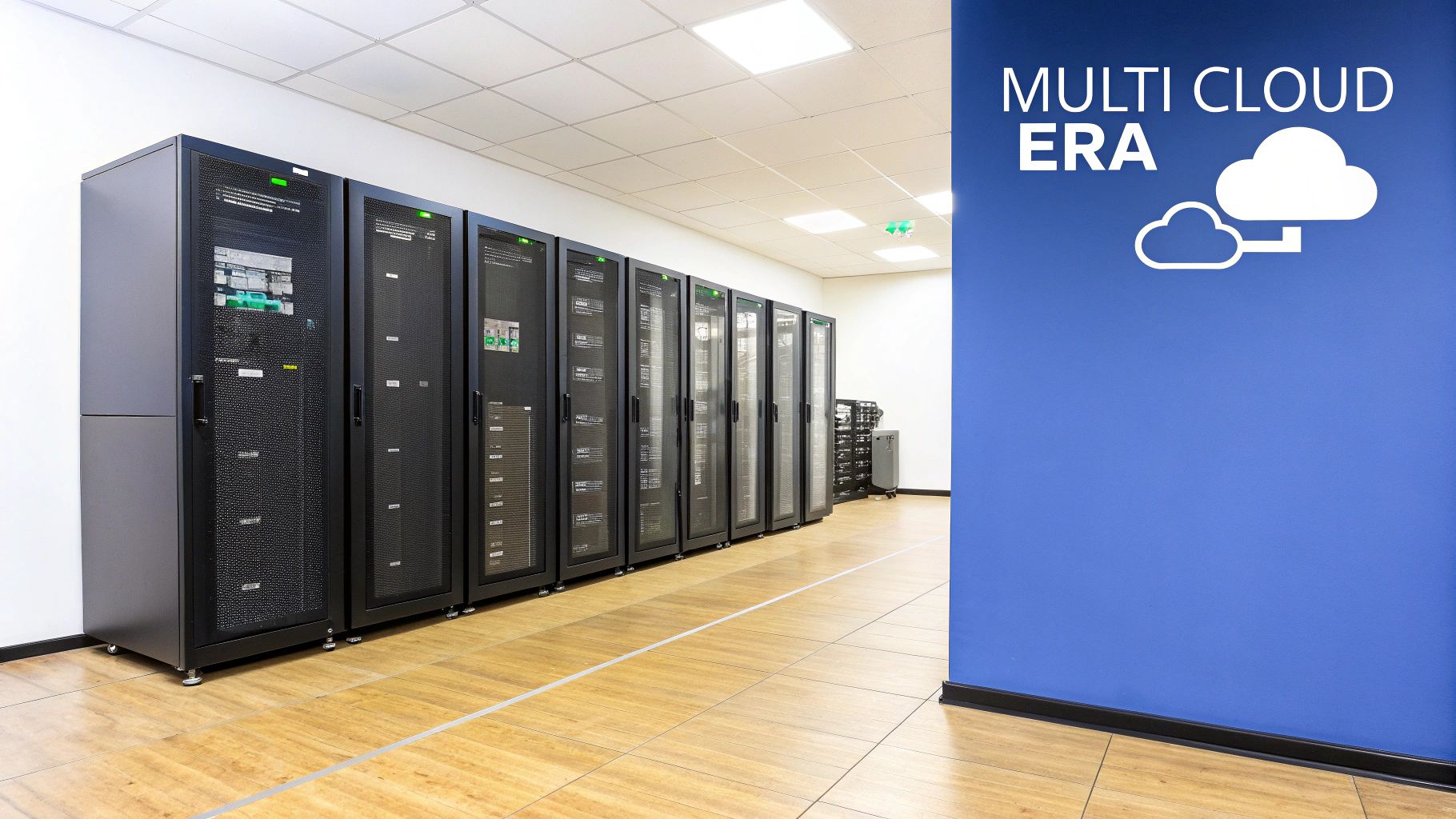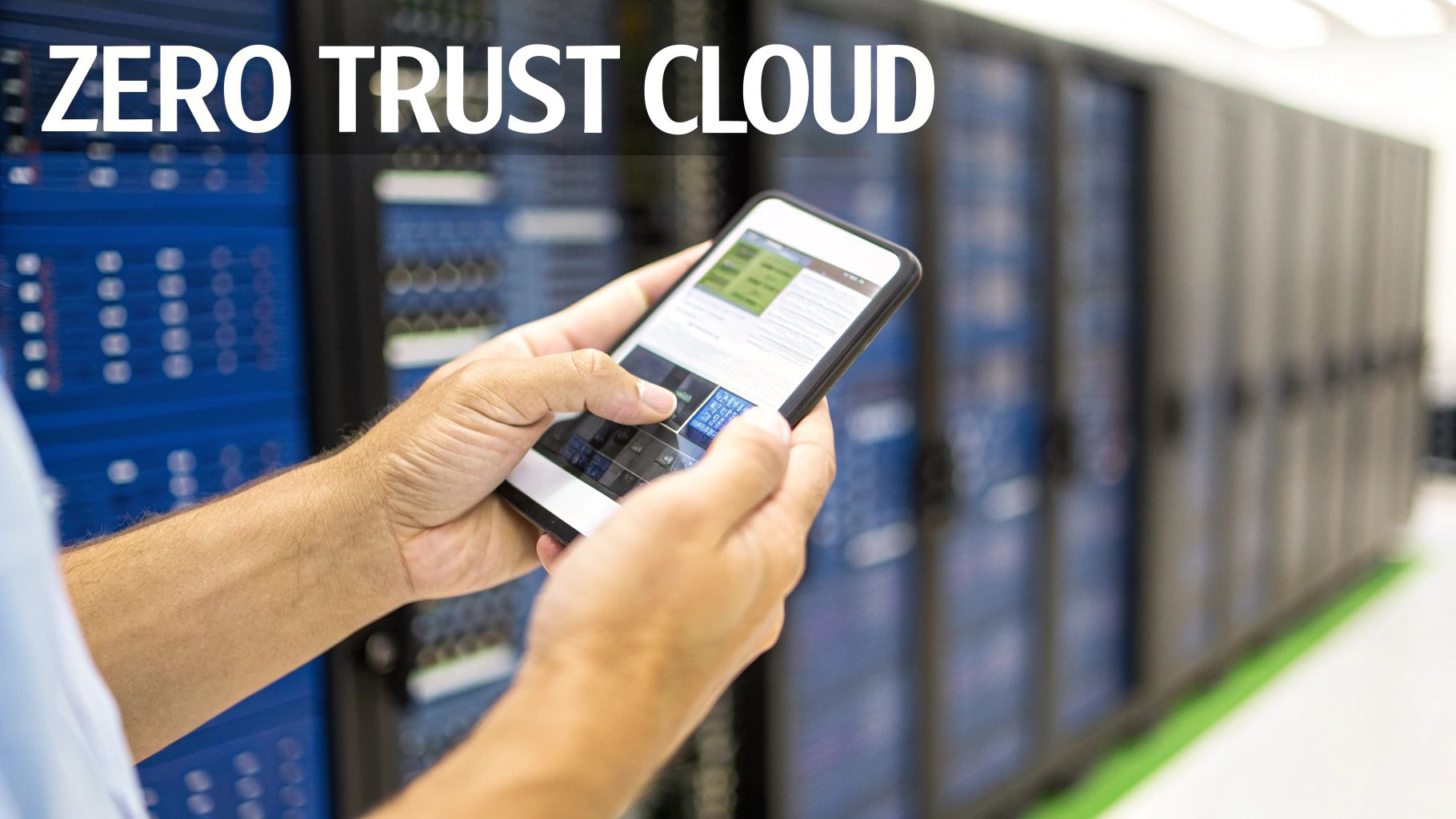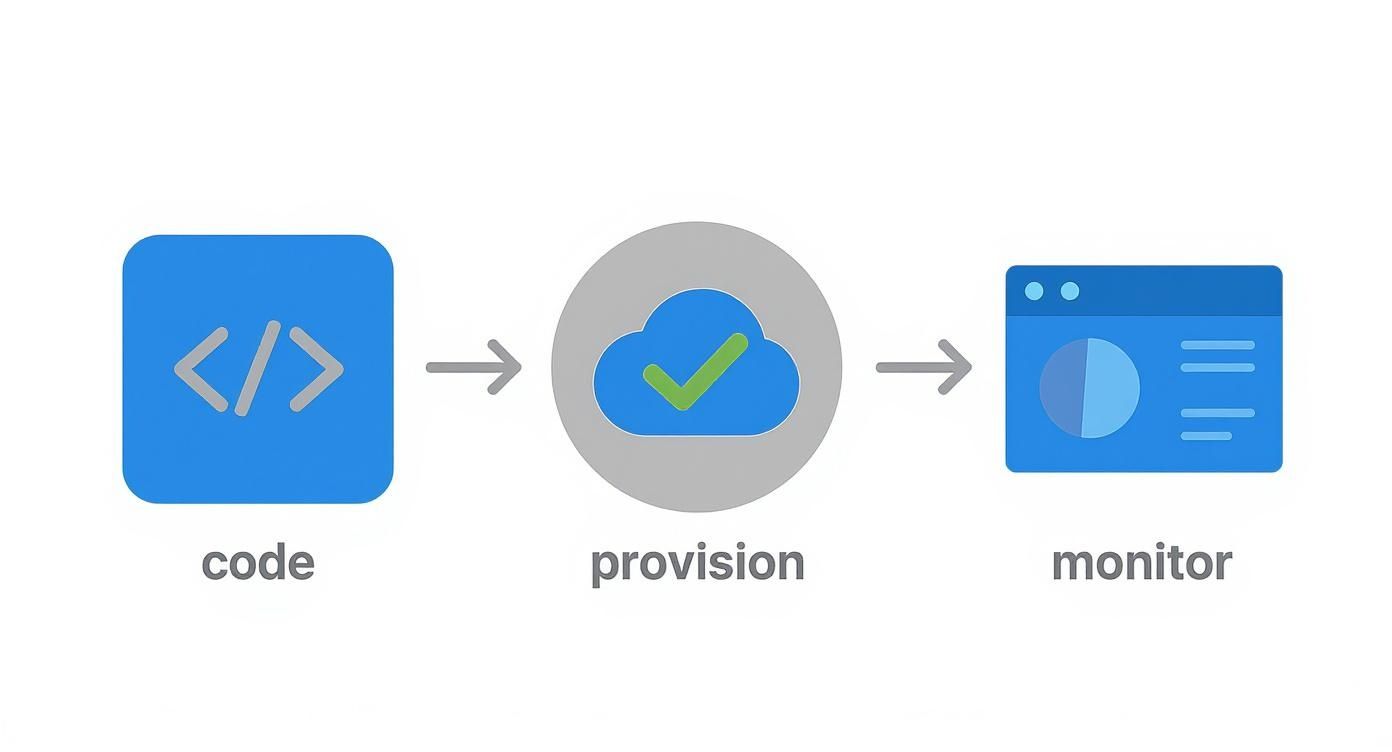To really get a handle on a multi-cloud environment, you need a strategy that ties everything together. We're talking about unified governance, tight security, smart cost management, and a healthy dose of automation. This isn't just about using a few different cloud services; it's about making them work as a single, efficient, and well-oiled machine.
The New Reality of Enterprise Multi Cloud

Let's be clear: multi-cloud isn't some fringe trend anymore. It’s the standard way modern businesses operate. But there's a huge difference between just using services from AWS, Azure, and Google Cloud and actually managing them as one cohesive system. That second part is where things get tricky, and this guide is here to cut through that complexity.
The move to multi-cloud is almost always a deliberate, strategic decision. Companies are doing this to get their hands on best-in-class tools for specific jobs or to build more resilient systems. A massive driver is simply avoiding vendor lock-in, which gives you more leverage and keeps your technical options open down the road.
And this isn't just a handful of companies. The adoption is massive. By 2025, it's expected that over 89% of large organizations globally will have embraced multi-cloud architectures. This isn't just about spreading workloads around; it's a strategic move for better team autonomy and easier compliance. You can find more great insights on multi cloud business strategies on growin.com.
Core Pillars of a Successful Framework
To wrestle your multi-cloud infrastructure into shape, you need a solid framework. Think of it as a roadmap built on four essential pillars. Each one tackles a different piece of the puzzle, from keeping costs in check to making sure your operations run smoothly everywhere.
Here are the foundational components we're going to break down:
- Unified Governance and Compliance: This is about creating one set of rules that applies across all your clouds. It’s how you keep things consistent and stop configuration chaos before it starts.
- Robust Security and Identity Management: You need a single, unified security posture. That means centralizing who can access what and how you detect threats, no matter which cloud an asset lives in.
- Smart Cost Optimization: Getting a grip on spending starts with seeing it all in one place. Centralized visibility across providers is the only way to spot waste and make sure you're getting the most bang for your buck.
- Strategic Automation: Automation is your best friend for getting rid of tedious, manual work. It ensures that tasks like provisioning and patching happen the same way, every time, across every cloud.
By mastering these four areas, you can transform a chaotic collection of cloud services into a powerful, integrated asset. This framework gives you the structure to innovate quickly without losing control.
In this guide, we’ll dive deep into each of these pillars. I’ll share practical steps, real-world examples, and workflows to help you build a management strategy that actually works. We'll kick things off with establishing a centralized governance framework, the first step to bringing order to the chaos.
To put it all together, here’s a quick summary of the essential components for any effective multi-cloud management strategy. Think of these as the non-negotiables for success.
Table: Core Pillars of Multi Cloud Management
| Pillar | Primary Goal | Key Actions |
|---|---|---|
| Governance & Compliance | Establish consistent control and policies across all cloud environments. | Create a central policy engine. Automate compliance checks and reporting. Standardize tagging and resource organization. |
| Security & Identity | Maintain a unified and robust security posture everywhere. | Implement a centralized Identity and Access Management (IAM) solution. Use a single platform for threat detection and response. |
| Cost Optimization | Gain complete visibility and control over multi-cloud spending. | Aggregate cost data into a single dashboard. Set budgets and alerts. Identify and eliminate idle or underutilized resources. |
| Automation | Streamline operations and reduce manual effort for consistency. | Use Infrastructure as Code (IaC) for provisioning. Automate routine maintenance tasks. Create operational playbooks. |
Focusing on these four areas will give you the foundation you need to not just manage, but truly master your multi-cloud environment.
Creating a Centralized Governance and Compliance Framework

Without a central rulebook, a multi-cloud environment can quickly spiral into chaos. You end up with inconsistent configurations, glaring security gaps, and compliance violations becoming the norm, not the exception. To get a real handle on multi-cloud operations, you need a unified governance model that establishes order across every provider you use.
This isn't just about writing policies and hoping for the best. It’s about building a practical framework that enforces rules automatically. The goal is to create guardrails that empower your teams to innovate safely, knowing they are operating within a secure and compliant structure.
Think of it as the constitutional law for your cloud infrastructure, a single set of principles that applies equally to your workloads on AWS, Azure, and GCP.
Defining Your Global Policies
The first real step is defining your global policies. These are the non-negotiable rules that govern how your teams manage resources, handle security, and store data. It’s best to start by focusing on the areas that pose the biggest risks if left unchecked.
Your initial policy set should lock down three critical areas:
- Resource Tagging: Mandate a consistent tagging strategy for every single resource launched. This is the foundation for everything from cost allocation and security grouping to automation. For example, you might require tags like
owner,project,environment, andcost-centeron all new virtual machines. - Access Controls: Establish baseline Identity and Access Management (IAM) roles. Define what a "developer" or "data scientist" can and cannot do, and make sure these roles are mirrored across all your cloud platforms to prevent privilege creep.
- Data Residency: Clearly define where different types of data are allowed to live. If you have to meet regulatory requirements like GDPR, your policies must enforce that customer data from the EU remains within EU-based data centers, no matter which cloud provider is hosting it.
These policies form the bedrock of your efforts to manage your multi-cloud environment predictably. They help you shift from a reactive stance, always cleaning up messes, to a proactive one where problems are prevented before they even happen.
The Role of a Cloud Center of Excellence
A Cloud Center of Excellence (CCoE) is the team that creates, maintains, and evangelizes these governance standards. This cross-functional group acts as the central brain for your entire cloud strategy, providing the guidance and tools everyone else needs.
A successful CCoE isn't a bottleneck; it's an enabler. Their job is to make the "right way" the "easy way" for your development teams.
The CCoE’s primary mission is to build paved roads for developers. They provide pre-approved templates, automation scripts, and best practices that have governance and compliance baked in from the start.
This approach dramatically reduces friction. Instead of having to manually check every deployment for compliance, the CCoE provides Infrastructure as Code (IaC) modules that already meet your standards. A developer who wants to spin up a database doesn't need to read a 50-page policy document; they can just use the CCoE-provided Terraform module that handles the tagging, encryption, and network rules for them.
Enforcing Policies with a Unified Engine
Defining policies is one thing, but enforcing them consistently across different cloud providers is the real challenge. Each cloud has its own native tools, like AWS Config or Azure Policy. Relying only on these native tools creates a fragmented enforcement system that’s incredibly difficult to manage at scale.
This is where a unified policy engine becomes a game-changer. Tools like Open Policy Agent (OPA) or other commercial platforms allow you to write a single policy and apply it everywhere.
Let’s look at a common scenario: your security policy dictates that no storage bucket can ever be publicly accessible.
- Without a unified engine, you'd have to configure this rule separately in AWS IAM, Azure RBAC, and GCP IAM. It's a lot to track and easy to miss something.
- With a unified engine, you write one policy in a common language (like Rego for OPA). This policy is then plugged directly into your CI/CD pipeline.
- When a developer tries to deploy a configuration that violates this rule, the pipeline automatically fails the build, preventing the misconfiguration from ever reaching production.
This "policy as code" approach fundamentally changes multi-cloud governance for the better. It shifts your compliance checks "to the left," catching issues early in the development lifecycle when they are easiest and cheapest to fix. It guarantees your rules are applied consistently, preventing compliance drift and giving you a single source of truth for your entire governance posture.
Unifying Your Security and Identity Management

When you're juggling multiple clouds, trying to secure each one with its own native tools is a losing game. It’s like trying to guard a house with different security systems for every door and window, it creates blind spots, inconsistencies, and openings that attackers are all too happy to exploit. A patchwork approach just won't cut it.
The only way to win is to build a single, cohesive defense strategy that stretches across your entire infrastructure. This means looking beyond the default tools from AWS, Azure, or GCP and adopting solutions that give you that coveted "single pane of glass" for your entire security posture. Your goal is simple: enforce the same rules, permissions, and threat detection everywhere.
Centralize Your Identity and Access Management
The bedrock of any multi-cloud security strategy is a centralized Identity and Access Management (IAM) system. Let's be blunt: relying on separate IAM tools for each cloud provider is a recipe for disaster. It guarantees permission sprawl, inconsistent user roles, and a massive headache for your team every time someone joins or leaves.
A single, dedicated identity provider changes the game entirely. You define a user's permissions once, and those rules apply consistently across every cloud they touch. This dramatically simplifies access control and tightens your security.
Think about the offboarding process. When a developer leaves, you disable their access in one central spot. Instantly, their keys to the kingdom are revoked across every single cloud service. This simple action closes the door on orphaned accounts, a classic vector for security breaches. For a deeper dive, check out our guide on role-based access control best practices.
Bring Zero Trust Principles into Your Multi-Cloud World
The old "castle-and-moat" security model is dead. In a multi-cloud reality, your services and data are scattered everywhere, so you have to work from a simple assumption: no network is inherently secure. This is the heart of Zero Trust, a model that demands strict identity verification for every person and device trying to access any resource, no matter where they are.
Putting Zero Trust into practice means taking a few key actions:
- Micro-segmentation: Isolate your workloads from one another with tight network policies. Just because two services are in the same virtual network doesn't mean they should be able to talk. All communication should be explicitly allowed, not permitted by default.
- Enforce Multi-Factor Authentication (MFA): This one is non-negotiable. MFA needs to be mandatory for everyone, especially for accounts with admin-level privileges. It’s one of the most effective defenses against stolen credentials.
- Least Privilege Access: Grant users and applications the absolute bare minimum permissions required to do their job. Nothing more. And just as importantly, review and trim those permissions on a regular basis.
A Zero Trust architecture isn't about protecting the network perimeter; it's about protecting each individual resource and piece of data. That mindset shift is essential when your perimeter has effectively dissolved across multiple clouds.
Consolidate Your Security Posture Management
The sheer complexity of multi-cloud makes modern governance tools absolutely essential. A 2025 survey found that 92% of organizations are already operating in multi-cloud environments, blending public and private clouds. But this often leads to fragmented visibility and a spike in risks from simple misconfigurations.
This is exactly where a Cloud Security Posture Management (CSPM) tool becomes your best friend. A good CSPM platform plugs into all your cloud accounts and acts as an automated security auditor, constantly scanning for misconfigurations, security risks, and compliance gaps.
Instead of your team manually bouncing between consoles to check security settings, a CSPM gives you a single, consolidated dashboard of your entire security landscape. It highlights the most critical issues first, so you know exactly where to focus.
For instance, a CSPM can instantly alert you if a developer accidentally makes a storage bucket public, a database gets deployed without encryption, or a critical security patch is missing on a VM. This proactive monitoring makes a complex environment manageable and frees up your team to fix real threats instead of just looking for them.
Mastering Multi Cloud Cost Optimization with FinOps
When you're juggling multiple clouds, uncontrolled spending is one of the biggest risks you'll face. Without a single, unified view, costs can spiral out of control fast, leaving you with shocking bills and a lot of wasted resources. The only real way to get a handle on it is to adopt a FinOps-centric approach. At its core, this is all about bringing financial accountability to the flexible, pay-as-you-go world of cloud.
This isn't just about slashing your bill, either. It’s about making sure every single dollar you spend on cloud infrastructure is actually driving business value. The journey always starts with getting complete visibility into your spending across every provider, from AWS to Azure and beyond.
To do this right, you'll need more than the native billing dashboards. Specialized cost intelligence platforms are a must-have for pulling data from all your sources into one understandable view. Only then can you start hunting down the inefficiencies that are quietly draining your budget.
Gaining True Spending Visibility
Fragmented visibility is the absolute enemy of cost control. If your teams have to jump between multiple consoles just to see what they're spending, you’ll never get the complete picture. It's a huge industry challenge, according to the FinOps Foundation’s 2025 State of FinOps Report, over 50% of organizations named workload optimization and waste reduction as their top priority.
A dedicated multi cloud cost management tool cuts through this chaos by pulling all your billing data into one central place. It normalizes the different pricing models and metrics from each cloud provider, so you can finally make true apples-to-apples comparisons.
Once you have this unified view, you can start answering the really important questions:
- Which project is driving the most cost on Azure this month?
- How much are we really spending on data egress across all our clouds combined?
- Are our Kubernetes costs on GCP trending up or down?
This level of detail is the first step toward making smart, informed decisions. It transforms cost management from a reactive guessing game into a proactive, data-driven process. For a deeper dive into the principles behind this, you can learn more about what is FinOps in our detailed guide.
From Visibility to Actionable Optimization
Once you can see everything clearly, the real work begins: optimization. This is where you hunt down waste and make your entire infrastructure more efficient. The easiest wins, or the "low-hanging fruit," are usually found in orphaned or idle resources, which are shockingly common in any complex environment.
These are the forgotten virtual machines, storage volumes, and other assets that were spun up for a project but never shut down. They just sit there, day after day, racking up charges for doing absolutely nothing. A good cost platform can automatically flag these resources for termination, delivering immediate and satisfying savings.
The next level of optimization is rightsizing. It’s about matching your instance types to their actual usage data, not just the initial guesstimates. So many teams overprovision resources "just in case," leading to significant and sustained waste.
By analyzing real CPU and memory usage over time, you can safely downsize instances without ever hurting performance. For instance, a development server humming along at just 10% CPU utilization doesn't need to be a large, expensive instance. Rightsizing it could easily cut its cost in half or even more.
Finally, you need to be strategic with commitment-based discounts like Savings Plans or Reserved Instances. These can offer massive savings, but trying to manage them across multiple clouds is a complex headache. Automation tools can help you dynamically adjust your commitments to maximize savings while still giving you the flexibility you need.
Comparing Multi Cloud Cost Management Platforms
Choosing the right tool is a critical step in getting your multi-cloud costs under control. Different platforms bring different strengths to the table, so it's important to find one that fits your company's needs and technical maturity. It's not a one-size-fits-all situation.
To help you get started, here's a quick look at a few of the leading options and what they do best.
| Tool | Key Features | Best For |
|---|---|---|
| CloudZero | Provides granular cost intelligence without relying on tags. Maps costs to products, features, and customers. | Organizations that need deep visibility into their unit economics and cost of goods sold (COGS). |
| Hystax OptScale | An open-source FinOps platform with strong support for Kubernetes cost tracking and resource sizing recommendations. | Teams that want a flexible, open-source solution and have a strong focus on Kubernetes environments. |
| Flexera One | A comprehensive platform that combines FinOps with IT asset management and SaaS governance. | Enterprises that need a single source of truth for all their IT and cloud assets, not just cloud spending. |
Each of these platforms can provide immense value, but the best choice depends on what you're trying to achieve. If you're heavily invested in Kubernetes, an open-source tool like OptScale might be perfect. If you're a large enterprise needing a holistic view of all IT assets, Flexera One is a strong contender. The key is to evaluate them against your specific challenges.
Leveraging Automation for Consistent Operations
In a multi-cloud world, trying to do things manually is a recipe for disaster. It’s not just inefficient; it’s a direct path to inconsistency and human error. When you're managing environments across AWS, Azure, and GCP, tasks like patching, provisioning, or backups done by hand will eventually lead to something breaking.
Automation is the only realistic way to enforce consistency and build reliability across your entire infrastructure. It takes the guesswork out of the equation. By turning your operational tasks into code, you guarantee they run the same way every single time, no matter which cloud they’re on. This is how you cut down on the mind-numbing, repetitive work and let your engineers get back to building things that matter.
Standardize Provisioning with Infrastructure as Code
The bedrock of any modern multi-cloud automation strategy is Infrastructure as Code (IaC). Tools like Terraform have become indispensable because they let you define and manage everything in a single, version-controlled codebase. Instead of clicking around in different cloud consoles, your teams write configuration files that spell out exactly what you want your resources to look like.
This approach pays off in a big way:
- Consistency: The same code can spin up identical environments across all your clouds, which kills configuration drift before it starts.
- Speed and Efficiency: Need a new dev environment or a DR site? It's just a simple, repeatable command away.
- Version Control: Every infrastructure change is tracked in Git. That means you get a crystal-clear audit trail and the power to roll back changes if something goes wrong.
A version-controlled codebase for your infrastructure is a game-changer. It transforms provisioning from a manual, error-prone art into a reliable, automated science, which is critical when you need to manage multi-cloud deployments at scale.
Think about it this way: a single Terraform module can define a secure, compliant virtual machine complete with your standard networking rules, tagging policies, and monitoring agents. When a developer requests a new server, they use that module. You can rest easy knowing it meets all your company’s standards, regardless of which cloud it's deployed on.
Automate Routine Operational Tasks
Automation isn't just for day one. It’s absolutely essential for the day-to-day grind that keeps your systems humming. These routine, but critical, activities are perfect candidates for automation scripts that can run on a schedule or get triggered by an event. The time saved and risk avoided here are massive. To see how this fits into a bigger picture, check out our guide on orchestration in cloud computing.
Here are a few common scenarios where automation is a lifesaver:
- Security Patching: An automated script can scan all your VMs across every cloud, flag missing security patches, apply them during a maintenance window, and report the results. This closes the window on known vulnerabilities fast.
- Data Backups: Forget manual snapshots. Automation ensures critical databases and storage volumes are backed up consistently, following your data retention policies to the letter.
- Disaster Recovery Drills: You can automate the entire process of failing over to a secondary region or even a different cloud provider. This not only proves your DR plan works but makes the process quick and reliable in a real emergency.
Unify Monitoring with a Single Observability Platform
You can't automate what you can't see. In a multi-cloud setup, relying on the native monitoring tools from each provider creates blind spots. Your teams are forced to jump between different dashboards, making it almost impossible to get a complete picture of system health or troubleshoot problems that cross cloud boundaries.
That's why a unified observability platform isn't a luxury; it's a necessity. Tools like Datadog or New Relic pull in logs, metrics, and traces from all your services, no matter where they run, into one searchable view.
This centralized approach helps your teams solve issues faster because all the data is in one place. They can quickly connect an error spike in an app on GCP to a database performance problem on AWS, slashing the mean time to resolution (MTTR) and reducing operational burnout.
Building Your Strategic Multi-Cloud Roadmap
Getting a handle on your multi-cloud environment isn’t a project you finish and walk away from. It's a continuous practice. You have to keep refining your strategy as your infrastructure grows and your business needs change. The best way to do that is by building a clear, actionable roadmap that ties governance, security, and cost optimization into one cohesive plan.
Think of this roadmap as your guide, whether you're just dipping your toes into multi-cloud or you're looking to bring more order to a mature, sprawling environment. The goal is always a delicate balancing act: you want the flexibility that multiple clouds offer, but you also need the efficiency and control that comes from centralized management.
Prioritizing Your Next Steps
The key is to move forward with small, incremental improvements that deliver real value right away. Don't try to boil the ocean. Instead, create a simple checklist based on your team's biggest pain points and start knocking them down.
Here are a few practical places to start that have a big impact:
- Establish a Governance Baseline: Make tagging mandatory for every new resource you deploy. I can't stress this enough. It's the foundation for everything else, cost allocation, security policies, and automation.
- Centralize Identity Management: If you haven't already, move to a single sign-on (SSO) solution. Unifying access control instantly shrinks your security risks and makes life easier for everyone.
- Gain Cost Visibility: You can't optimize what you can't see. Deploy a cost management tool that gives you a single pane of glass across all your cloud providers.
- Automate One Repetitive Task: Pick something simple but annoying, like shutting down non-production instances overnight. Automate it. This small win proves the value of automation and builds momentum for bigger, more complex workflows.
This simple diagram shows how a basic three-step flow can bring consistency to your operations.

This workflow is all about creating a repeatable cycle for coding, provisioning, and monitoring to ensure your deployments are reliable every single time.
Future-Proofing Your Management Strategy
Looking ahead, a few trends are already reshaping how we manage multi-cloud environments. Hybrid cloud models, where on-prem infrastructure works hand-in-hand with public clouds, are becoming standard. This adds another layer of complexity that demands a unified management approach. At the same time, AI is starting to play a huge role in automating complex jobs like performance monitoring and threat detection.
The market for these advanced tools is blowing up. The global multi-cloud management market was valued at USD 10.71 billion in 2024 and is projected to hit USD 75.15 billion by 2032. That’s a compound annual growth rate of nearly 28%, all driven by the need for better analytics and strategic control. You can learn more about the growth of the multi-cloud market on fortunebusinessinsights.com.
Your roadmap must be a living document. Regularly revisit and adjust it to incorporate new technologies and changing business goals, ensuring your multi-cloud strategy remains a competitive advantage.
Got Questions About Multi-Cloud? We've Got Answers.
Jumping into the multi-cloud world can feel like navigating a maze. It's natural to have questions. Here are some of the most common ones we hear from teams just like yours, along with some straight-talking answers.
What Is The Biggest Challenge To Manage Multi-Cloud Environments?
Hands down, the biggest hurdle is complexity. Every cloud provider has its own set of tools, APIs, and security models. When you try to juggle all of them at once, you create operational headaches and dangerous blind spots.
Without a single, unified way to manage everything, that complexity quickly spirals into security risks, compliance headaches, and costs that are completely out of control. A smart multi-cloud strategy doesn't add to the noise; it cuts through it by centralizing how you handle governance, security, and cost visibility.
Is Multi-Cloud More Expensive Than Single-Cloud?
It definitely can be, but it doesn't have to be. The allure of multi-cloud is grabbing the best-of-breed services or finding better pricing for a specific job. The catch? The operational overhead of managing it all can eat up those savings and then some.
The secret to making it work is a solid FinOps practice. By using the right cost management tools and a healthy dose of automation, you can hunt down waste and make sure you're getting the most bang for your buck on every platform. Do it right, and you can absolutely come out ahead financially.
How Do I Start Implementing A Multi-Cloud Strategy?
The key is to start small. Don't try to boil the ocean on day one. Your first move should be to build a solid foundation you can build on later. A great starting point is to implement a centralized identity management solution and a dead-simple, consistent resource tagging policy.
The most effective first step is gaining unified visibility. Deploy a multi-cloud cost management tool to get a single pane of glass into your spending. This data will immediately highlight your biggest opportunities for optimization and guide your next steps.
Once you can see what's going on and have some basic governance in place, you can start automating routine tasks and creating standardized templates for deployments. This phased approach lets you score some quick wins, show real value, and build momentum for getting the whole organization on board.
Ready to stop wasting money on idle cloud resources? CLOUD TOGGLE makes it simple to automate server schedules across AWS and Azure, cutting costs without complex configurations. Start your free 30-day trial and see how much you can save at https://cloudtoggle.com.




